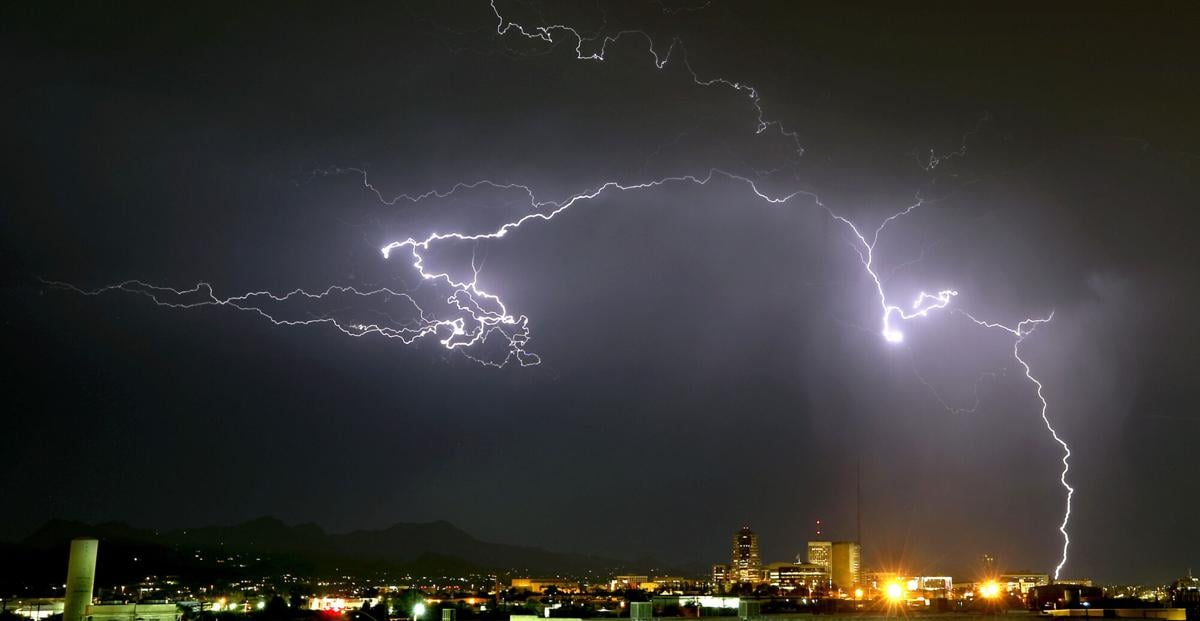Tucson Electric Power Co. worked nonstop over the weekend to restore power to about 56,000 local customers after a monsoon storm ripped across Tucson on Friday night, causing widespread outages.
The company restored power to about 40,000 overnight, but about 16,000 were still out of power Saturday morning. All but about 275 were restored by Sunday night.
By 2 p.m. Monday, power was restored to all but about 130 customers, TEP spokesman Joe Barrios said.
Areas that were hit hardest, and took the longest to restore, include an area west of Interstate 10 and north of West Speedway, where a string of snapped power poles caused about 1,600 customers to lose power, and an area near East Fort Lowell and South Country Club roads, where nearly 1,800 residents lost power.
While TEP prepares its system and staff to deal with storm damage, Friday night’s storm was special in severity and scope, TEP spokesman Joe Barrios said.
That prompted the company to bring line crews from its sister rural utility, UniSource Energy Services, from Nogales and Lake Havasu City, and hire some subcontractors for some work.
“We did bring in additional resources because we felt that it was necessary to get customers back in service more quickly, because the (storm) damage was unlike anything we’ve seen in a number of years,” Barrios said, adding that the company feels its field staffing levels are adequate.
TEP crews work round the clock to restore service, with more than 300 line workers who are rotated in and out in shifts to keep the work going nonstop, Barrios said.
Wind bursts topping 50 miles per hour toppled TEP power poles in several places around the city.
Barrios said storms typically will blow down or damage about 100 wooden power poles during the summer, but TEP has had to replace more than 160 poles within two weeks.
Barrios said the company generally prioritizes resources and repairs where it can get the most customers back online the quickest while also prioritizing hospitals and customers on life-saving medical equipment.
With isolated outages, TEP can often restore power quickly by switching customers to different, functioning circuits, but with a widespread outage that gets tricky, Barrios said.
“Those circuits only have so much capacity and we don’t want to overload those circuits either,” he said. “Then we run the risk of literally overloading equipment and causing another outage — it’s a little bit of a balancing act.”
There are even fewer options in more sparsely populated areas where a home or business may be served by a single, “radial” line, Barrios said.
Though they can last for decades, wooden power poles are particularly vulnerable to high winds, and TEP has a program to test and replace them with metal poles where it makes sense, Barrios said, noting that the company sometimes installs metal “stopper” poles spaced amid wooden poles, to limit damage when storms strike.
But wooden poles remain in areas where the utility’s lift trucks can’t drive, so instead, linemen must climb the poles with spiked boots, Barrios said, citing an area in the Foothills that suffered major pole damage about two weeks ago and again on Friday.
Some TEP customers commented in social media posts that the company could avoid storm damage by replacing its overhead power lines with underground installations.
That would protect lines from storm damage, but the cost is “prohibitively expensive,” Barrios said.
During discussions on TEP’s plan to string up high-voltage power lines through midtown Tucson, TEP opposed adding the cost to the bills of all of its ratepayers, estimating the cost to bury six or seven miles of line at more than $40 million, or 10 to 13 times the cost of overhead installation.
In May, Tucson voters overwhelmingly rejected a new city of Tucson franchise agreement with TEP that would have increased the local franchise fee customers pay on their bills to fund underground line installation.
Because of the size and duration of Friday’s outage, TEP will have to file a report with the Arizona Corporation Commission, which regulates most power companies and cooperatives in the state.
Barrios said the company improved its System Average Interruption Duration Index — the number of interruptions per consumer per year — to 61.8 minutes last year, compared with 73.8 minutes in 2021, despite higher temperatures and increasing peak energy usage during the summer.
TEP says it has been in the top quartile of U.S. power for system reliability and outage response since 2012.
This time-lapse video shows a large storm cell move in over Tucson from the southeast on Monday, July 17.





